A-Nrd Studio’s Bospoke Expertise Elevates Guest Experience
A-Nrd Studio, an award-winning, London-based multi-discipline design studio, specializes in creating immersive and transportive environments for the hospitality industry across the UK.
In this exclusive interview, we sit down with the studio’s founders, Alessio Nardi and Lukas Persakovas, to explore their journey from working with renowned designers and projects internationally to establishing their own unique design ethos. The discussion highlights their extensive expertise in bespoke furniture design, their approach to integrating custom pieces into their projects, and how these elements enhance the overall experience in hospitality spaces.
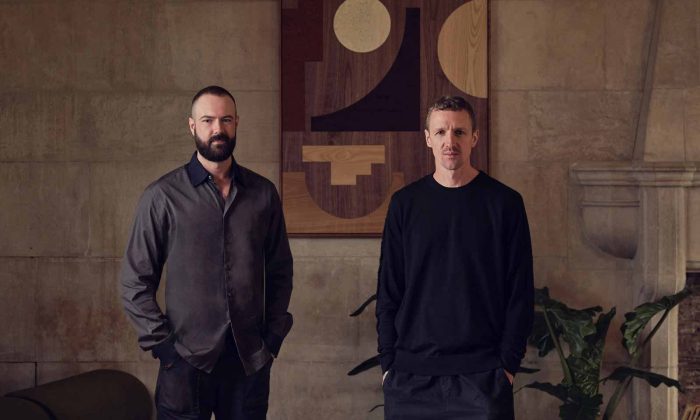
A-Nrd Studio, Founders, Alessio Nardi and Lukas Persakovas
Could you introduce yourselves and A-nrd studio? We’d love to hear more about what initially inspired you to start your studio and how your international experiences with renowned designers and projects have shaped your unique design philosophy.
When we started our careers, the end goal was always to have an independent studio. For me, I was very focused in the early days of my career in gaining as much experience in the industry across a broad range of design practices. I started off working in the art world, before moving into lighting design and then on to commercial interior design. The last practice I worked at before establishing A-nrd was an architectural practice in Amsterdam on large-scale international retail schemes. It was here that I met Lukas. His background was very similar to mine, along with experience in furniture design so we really had a very synergistic background. When I founded the studio in 2015, I knew he was the person to call to be my creative partner.
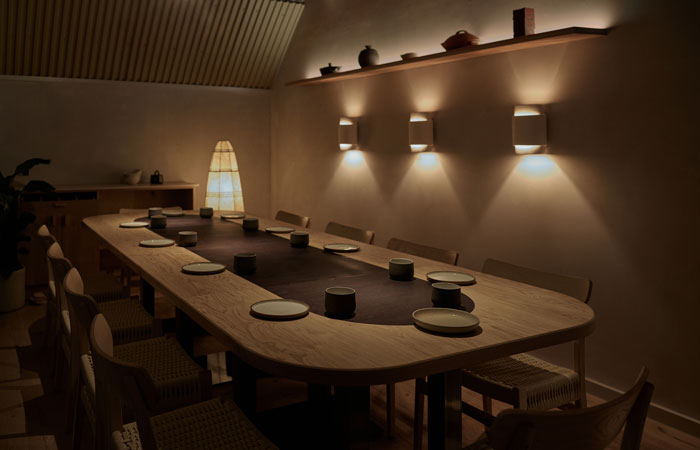
Akara, Borough, London
Our shared experiences made us notice a gap in the market, we often saw a disconnect between the design, the client and the end consumer which pushed us to bring a more hands on approach to our work and as such we have full visibility on the projects beginning to end and that’s what makes our work stand out and feel authentic. Our work is very transportive and immersive which has been certainly shaped from our career experiences as each of the studios we worked created interiors or products that evoked a theatricality or strong narrative. As such our spaces are very imaginative but they feel intimate and familiar which is important within restaurant and bar design. More than just interior concepts, they feature a range of bespoke furniture and lighting concepts which we design.
Both of you have impressive educational backgrounds in industrial and product design—Alessio with qualifications from MIP Politecnico di Milano and London Metropolitan University, and Lukas from Vilniaus Dailes Akademija. How have these experiences equipped you for furniture design within your projects, and could you share key milestones where product and furniture design became integral to your interior design work?
Our university experiences gave us the foundations and importantly the technical knowledge for us to step into bespoke furniture and lighting design. Ezio Manzini, a mentor of mine at university was a pioneer in design for social innovation and sustainability which certainly had a lasting influence on me, but it really is in the workplace, on real time projects where you evolve the most. Designing something on paper and bringing it to life as a student for your own pleasure or to fulfil a brief is very different to working in a live environment where designs often need to be changed to suit the client, lead times can evolve, and technical issues can arise.
Both Lukas and I had worked previously worked within design studios where we experienced this first hand, designing and manufacturing products and projects for clients and for retail. I worked at Tord Boontje and Lee Broom which opened the door to working closely with local manufactures working end to end on the whole design process whilst Lukas worked at a manufacturing company that produced high end retail and fashion fittings for Dior and other big names where he gained the experience of working in technical detail as well as with the manufacturing of products also. Whilst there has always been a bespoke element of furniture or lighting design in all the early A-nrd projects, it was probably KOL which was the turning point. To really make it truly immersive and authentic we embraced the bespoke side more than ever, it was almost fully bespoke in fact and after that, our bespoke design became something of a signature for the studio.

Akara, Borough, London
How do you define bespoke furniture within the context of your studio’s work? When approaching a new project, how do you decide whether to go for a bespoke design or specify an existing piece to meet the design brief? In what ways do designs within supplier’s existing product portfolio’s not meet your needs?
I would say it’s quite an organic process and it depends on the project. We bring in bespoke lighting, furniture and decoration if we think that helps with the narrative, the material mix, the emotion of the environment. Bespoke or off the shelf, it must seamlessly work within the concept otherwise it doesn’t get chosen. We will mostly create a bespoke item if we see a gap within the concept or if we have a maker or a material which we would like to incorporate, that is when we will collaborate or make a custom product. There are also elements we would always create bespoke like upholstery items – all booth and sofa seating are usually designed by us and made with local upholsterers. Tabletops in restaurants are also usually bespoke.
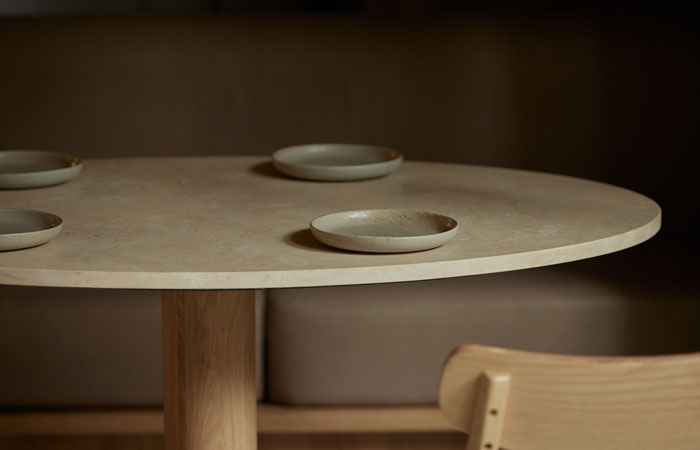
Akara, Borough, London
What significant impact can bespoke furniture have on the design and functionality of a commercial space? Could you discuss how custom pieces can transform these environments?
Bespoke furniture design gives us a point of difference as a studio and allows us to create products that are 100% right for the project – product, which is unique, sometimes subtle and sometimes bold. The interior of a project and its theme doesn’t need to be necessarily obvious or understood by the guest, it just needs to make them feel emotive so that they walk away from that dinner or cocktail knowing they had a great time and that’s because the environment was just as good as the menu.
We often create sofa style pieces of furniture that have completely different proportions of a standard sofa to fit the ergonomics of eating at a restaurant for instance. The style will make a guest feel comfortable and at ease but if that was a standard sofa they would walk away from that experience not knowing why wasn’t quite right, because the height or width was off for example. Its small details which make a customer journey positive and that’s where bespoke design can really have an impact. On the other hand, bespoke design is a lot of responsibility, on us as the designer and on the makers which we use to deliver a product that is fit for purpose.
Could you provide three examples of your projects where bespoke furniture was commissioned and describe the impact these pieces had on the overall space and client satisfaction?
As I mentioned earlier, KOL was almost a fully bespoke project. From the booth seating, the chairs and tables to the lighting and the flooring. We worked with Fernando Laposse to create a bespoke piece of artwork using corn husk which he utilises in a marquetry effect. We also asked him to create some bespoke pendant lights for the private dining room to bring that design element through the space. We took a 3-week research trip to Mexico ahead of the concept work to ensure that our work was authentic in style. The welcome desk is a bespoke hand-chiselled oak piece which we created. Three kitchen islands positioned in the centre of the restaurant were similarly crafted from oak with hand-chiselled counters.
KOL’s range of furniture was all created by A-nrd studio in collaboration with artisans in Italy and the UK. The whole furniture collection focuses on subtle detailing and natural materials, a nod to the modernist aesthetic found throughout Mexico. The tables are a mix of honed silver travertine stone and oak wood which has been hand-planed to add tactility. The stone tabletops seem to be floating, with accentuated interlocking leg details. The oak wood chairs also present the same hand-planed finish and sleek leather upholstery while the window benches are more of a sculptural piece with travertine block bases and a suspended leather backing. The communal table in the private dining room was also bespoke and features two hand-planed oak planks merged by a central concrete runner to create a sectional sharing table.
We worked closely with chef Santiago Lastro on the concept for KOL. It was important for both of us to create a space that was authentic and not cliché and a space that really worked for him and his team (the kitchen islands are the perfect example of this) and for the environment and emotion he wanted guests to experience.
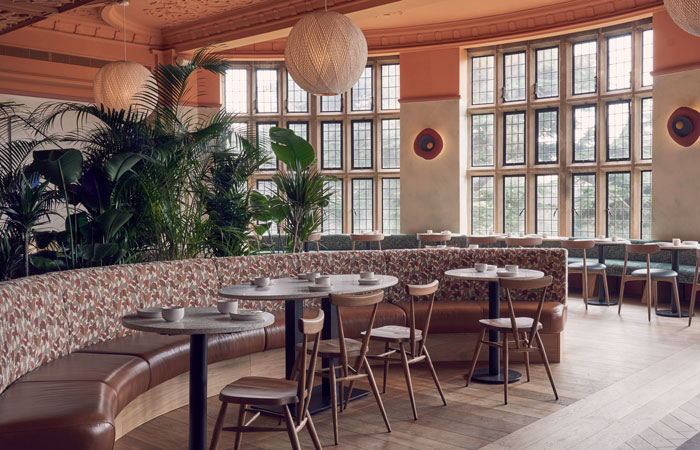
Birch, Selsdon, South London
At Birch Selsdon, the bespoke furniture and lighting had an overtly sustainable and hyper local angle. Most of the timber furniture we designed such as welcome desks, the booth seating in the dining room, communal tables, and the bedside tables in each of the 210 rooms were crafted by timber felled from the rewilding of the Birch estate. Beds and wardrobes and other wooden pieces were crafted bespoke by local makers and decorative details such as the marquetry elements on the wardrobes by Chelsea Vivash were commissioned by us. The lighting in the bedrooms were also designed in collaboration with local studio Micheal Ruh. We knew we wanted to incorporate recycled glass and after visiting the studio we collaborated to create something that felt very organic and something which provided a comfortable and inviting illumination. Within the design of Birch, we also created a few bolder design pieces including a bespoke S shaped sofa in a bright Klein blue which sits in the Orangery along with a bespoke neon sculptural lighting piece which hangs in the main stairwell and was inspired by the original stained-glass window of the gothic manor.
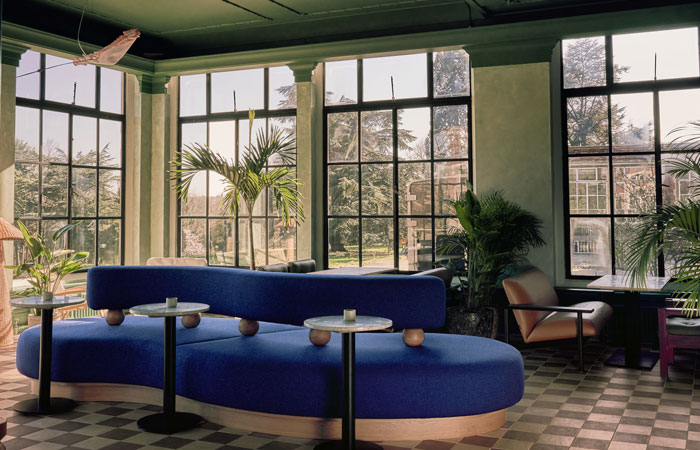
Birch, Selsdon, South London
Whilst Birch featured a strong bespoke element it was very much a mix of custom design, vintage pieces sourced from local markets and antique dealers and contemporary off the shelf pieces. The team at Birch wanted to create a very contemporary space that felt familiar and in such a vast space, an interior that seemly transitioned from one area to the next and the furniture mix worked well for that. New pieces which we incorporated were sourced by Dodds & Shute, a design-led procurement company dedicated to sourcing the most sustainable furniture and lighting and who tracked the carbon footprint of every item procured across the estate.
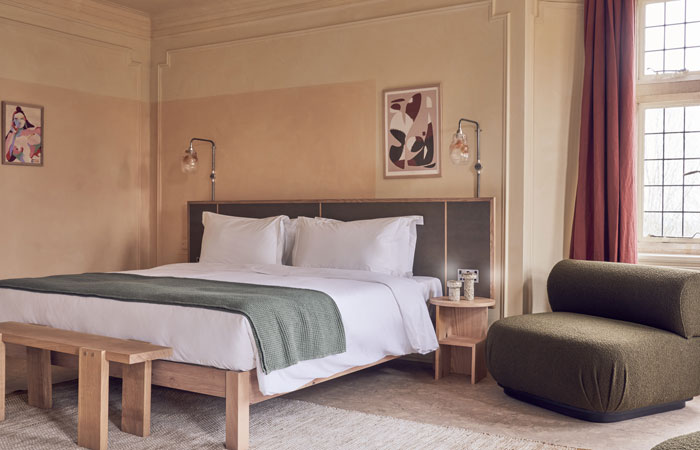
Birch, Selsdon, South London
For Darjeeling Express which we relocated back to Kingly Court for Asma Khan in 2023, we created furniture, booths and tables inspired by Asma’s ancestral home and her train journeys on the Darjeeling Express. The benches have a curved shape and slatted design whilst the tables are crafted from Burl wood.
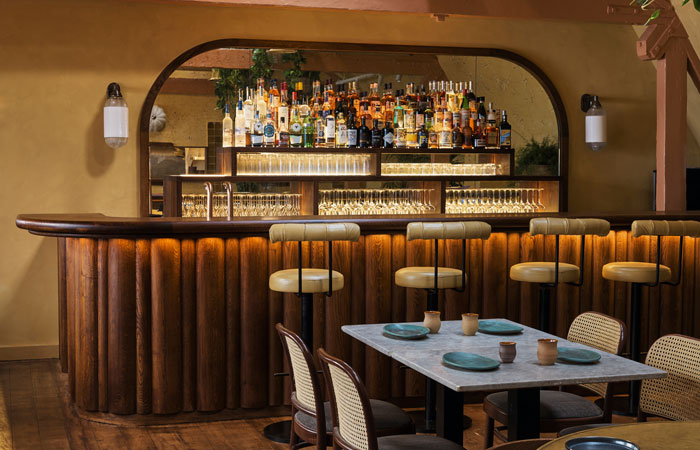
Darjeeling Express, Soho, London
This project was quite an interesting one as we inherited a lot of furniture from the previous Covent Garden location. As a studio we’re very focused on sustainability and reducing the impact each project has on the environment, so we repurposed a lot of the furniture. With some small adjustments an old refuse cover was re-purposed as a new reception desk. An old sideboard became a new waiter station. We also created a large communal table crafted from pigmented concrete, chosen to reference one of India’s most used materials, the large sharing table features a striped terracotta and ink blue tabletop design framed by metal. A curvaceous and monolithic cocktail bar with vintage effect mirrored backbar is unquestionably one of the stars of the space. This beautifully crafted bar made from solid dark oak features a scalloped front counter inspired by Mughal architectural shapes. Having worked with Asma for many years we knew exactly what was needed to create a transportive space for her which really celebrated her background in subtle ways, whilst allowing the food to be bold stars of the show.
When initiating the design for a bespoke piece of furniture, what is your starting point? Where do you typically find inspiration, and how do you navigate the complexities of production methods and material selection to bring your vision to life?
We usually create furniture that contributes to the narrative of the space. In Kolae, a Thai restaurant set in an old coach house in Borough market, the vibe is a kind of modern warehouse. Here the furniture is inspired by Thai stilt architecture. We wanted a visual language that was subtle and could be used across the different types of furniture from bar stools to benches and tied all three floors together.
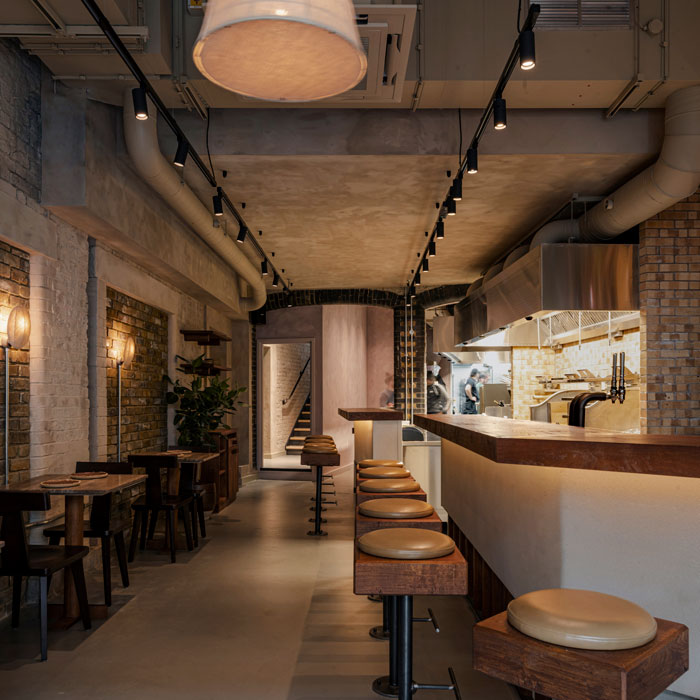
Kolae, Borough, London
The inspiration usually comes from the theme of the restaurant or from the chef and their background. As with Asma Khan and Darjeeling Express, it was Asma’s amazing photo collection which was the source of inspiration.
We have an extensive material library at the studio, and we always keep an eye on new materials and production methods, often visiting spaces like the Material Lab in central London and visiting fairs such as the Surface Design Show.
As with any interior project, the material selection and production methods are often dictated by budgets and time frames, but we have great relationships with local makers and material suppliers here in the UK and in Italy where we source a lot of natural stone.
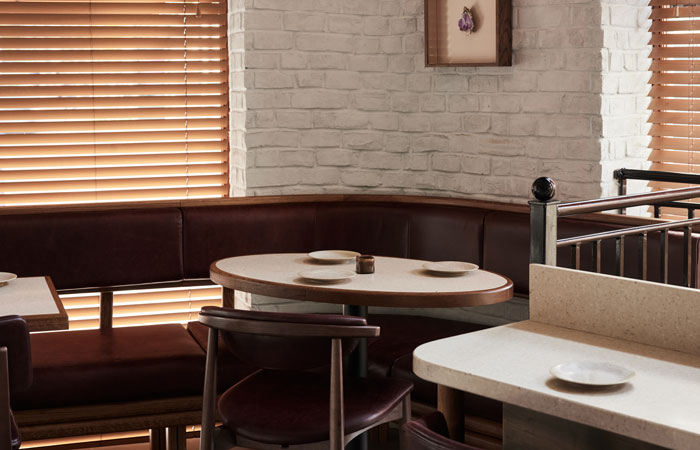
Pearly Queen, Shoreditch, London
Maintaining strong supplier relationships is crucial in bespoke furniture design. How do you cultivate and maintain these relationships, and what role do they play in realizing your creative visions?
It’s key to trust your suppliers, they have the know-how. We often have to adapt the design together following their suggestions to optimise the production or durability and so forth.
As Lukas and I have so much experience in manufacturing, we would never go to our makers with something unrealistic.
With most of our makers, we are in inconstant communication throughout the whole year as they are working on multiple designs for different project of ours at the same time so it’s important to always speak and have regular video calls. The way we work is a very organic process, and very collaborative to achieve and realise a successful design.
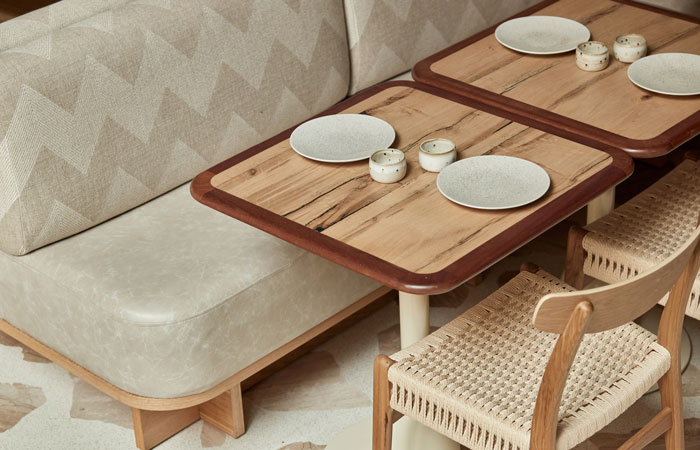
Milk Beach, Soho, London
Working with suppliers on bespoke pieces must present unique challenges and opportunities. Could you elaborate on some of these experiences and how they have influenced your approach to design?
Sometimes the bespoke elements can be quite challenging, in fact stressful at times as the client is trusting you fully on the design, the functionality of the piece and its longevity too. Opening a restaurant or bar is an expensive business and the interior needs to be designed to last.
A bespoke design will be successfully realised only if done properly. We as a studio have to also translate this trust into our manufactures. If something goes wrong, it has a bit of a domino effect so there is a lot of pressure on us and we constantly must be in communication with the suppliers, go to factory visits, make sure prototyping is allowed in costing etc.
The result, however, is very rewarding and worth the stress. Part of KOL’s success for instance is due to the high level of bespoke elements. The interiors almost received as much press as the food itself. That’s when you know you have done a great job.
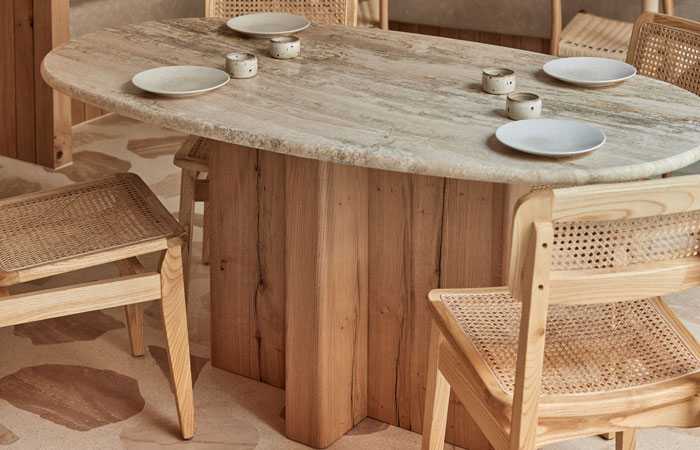
Milk Beach, Soho, London
In what ways does bespoke furniture contribute to enhancing the user or guest experience in the spaces you design? How do these custom design elements meet both functional and aesthetic needs?
Bespoke furniture design brings with it full control of the ergonomics of a piece. As I mentioned in a previous answer, a bespoke sofa at dining height for instance can have a huge effect on how the customer enjoys the time sat at the table. Bespoke furniture really allows you to optimise the use of the space, its flow and therefore the customer journey as well as of course the aesthetics.
We like to create designs that have a residential feel but meet the requirements of a commercial space.
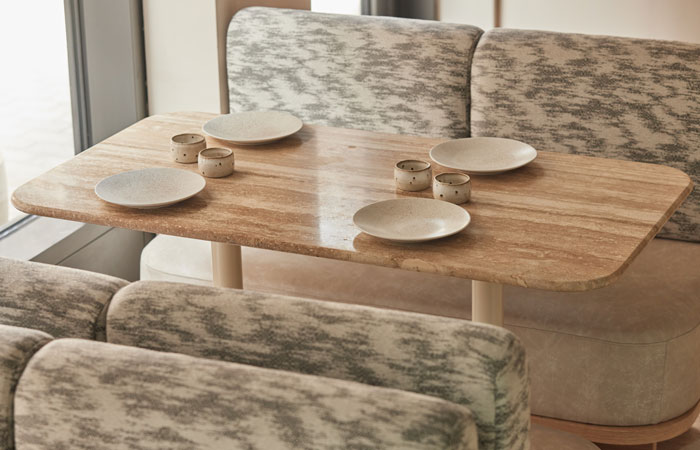
Milk Beach, Soho, London
With a strong commitment to sustainability, how does A-nrd Studio balance the demands for bespoke, tailor-made solutions with environmental principles? Does this commitment influence your choice of suppliers?
We prioritise working with local makers. This is part of our founding values and ethos as a studio, and as part of our approach to sustainability. We also look to use recycled materials where we can, or hyper local materials which not only bring a unique element to a design but also reduce the carbon footprint of a creation. As yet we haven’t had any challenges with regards to realising a particular design whilst needing to compromise on the materiality or sustainability of a piece, but perhaps that’s a question to ask us again in the future!
Looking ahead, what does the future hold for your studio? Do you have any upcoming projects or furniture designs you can share with us?
The last 12 months have been incredibly busy. We completed six projects in 2023 whilst simultaneously working on projects which will complete in 2024. We’re very excited to be working for a fifth time with Kudo Collective founders Amy Corbin and Patrick Williams on a new venture this year and thanks to the success of KOL, we’re working with Santiago Lastra on the design of his exciting new restaurant Fonda. We’re also thrilled to be working with new client such as the White Rabbit Group on the opening of Lina Stores new flagship restaurant on Shoreditch High Street as well as the VIP area at the Ministry of Sound and our second hotel which is a new boutique hotel in Edinburgh. We have always said that we would love to take on the challenge of working with a furniture or lighting brand to collaborate and develop a collection together and this year we’re exploring that which is something to watch out for in 2025!




